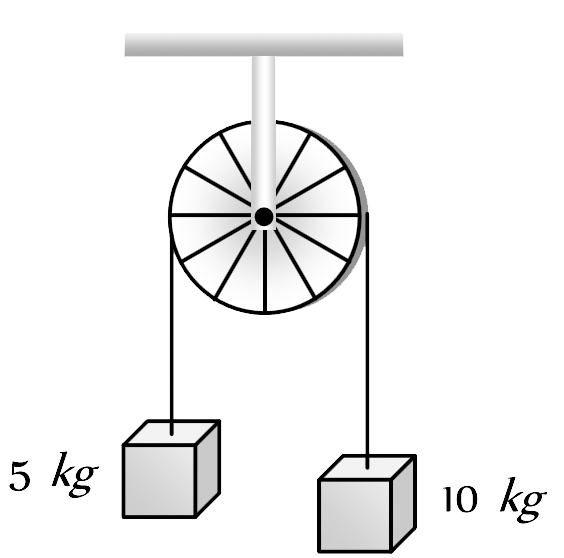A force →F=(6ˆi−8ˆj+10ˆk)N produces acceleration of 1ms−2 in a body. Calculate the mass of the body. Solution in Gujrati
∵Accleration a=∣∣→F∣∣m∴massm=∣∣→F∣∣a=√62+82+1021=10√2kg.
Topper's Solved these Questions
- NEWTONS LAWS OF MOTIONBook:ALLEN Chapter:NEWTONS LAWS OF MOTIONExercise:SWOE
Explore 44 Videos
- NEWTONS LAWS OF MOTIONBook:ALLEN Chapter:NEWTONS LAWS OF MOTIONExercise:EXERCISE-I
Explore 52 Videos
- NEWTON'S LAWS OF MOTION & FRICTIONBook:ALLEN Chapter:NEWTON'S LAWS OF MOTION & FRICTIONExercise:EXERCISE (JA)
Explore 4 Videos
- RACEBook:ALLEN Chapter:RACEExercise:Basic Maths (Wave Motion & Dopplers Effect) (Stationary waves & doppler effect, beats)
Explore 25 Videos
Similar Questions
A 2000 kg rocket is set for vertical firing the exhaust speed is 400 m/s to given an initial upward acceleration of 10m/s2. Find out the amount of gas ejected per second to supply the needed thrust (g=10m/s2)
View SolutionUSS 150) Two masses of 5 kg and 10 kg are connected to a pulley as shown. What will be the acceleration of the system (g= acceleration due to gravity)

View SolutionA piece of wire is bent in the shape of a parabola y=kx2 (y-axis vertical) with a bead of mass m on it. The bead can slide on the wire without friction. It stays at the lowest point of the parabola when the wire is at rest. The wire is now accelerated parallel to the x-axis with a constant acceleration a. The distance of the new equilibrium position of the bead, where the bead can stay at rest with respect to the wire, from the y-axis is:
View SolutionThe frequency of a radar is 780 MHz. After getting reflected from an approaching aeroplane, the apparent frequency is more than the actual frequency by 2.6 kHz. The aeroplane has a speed of
View SolutionA body, under the action of a force →F=6ˆi−8ˆj+10ˆk , acquires an acceleration of 1ms−2 . The mass of this body must be.
View SolutionA force F=(6hati-8hatj+10hatk) N produces acceleration of sqrt(2) ms^(-2) in a body. Calculate the mass of the body.
View Solutionबल 6ˆi−8ˆj+10ˆk के प्रभाव में एक पिंड 1 मीटर/सेकंड2 का त्वरण प्राप्त करता है । पिंड का द्रव्यमान है -
View Solutionकिसी पिण्ड पर बल →F=6ˆi−8ˆj+10ˆk आरोपित करने पर उसमे 2मी/से2 का त्वरण उत्पन होता है। पिण्ड का द्रव्यमान होगा
View SolutionIf a force →F=3ˆi−4ˆjN produces an acceleration of 10ms−2 on a body, then the mass of a body is
View SolutionA force vector applied on a mass is represented by →F=6ˆi+8ˆj+10ˆk and it accelerates it with 1 ms−1 . What will be the mass of the body ?
View SolutionForce on a mass vecF=6hati-8hatj+10hatk And the acceleration generated 1 I / सै^(2) is. Mass of the object will be
View Solutionकिसी बल →F=6ˆi−8ˆj N के प्रभाव में कोई पिण्ड 5ms−2 का त्वरण प्राप्त कर लेता है। पिण्ड का द्रव्यमान है -
View Solutionएक बल →F=(6ˆi−8ˆj+10ˆk)N किसी वस्तु में √2m/s2 का त्वरण उत्पन्न करता है, वस्तु के द्रव्यमान(kg) की गणना कीजिए।
View SolutionIf a body under the action of force (6ˆi+8ˆj−10ˆk) N. acquires an acceleration of magnitude 5ms−2. Then the mass of body is
View SolutionA force factor applied on mass is represented by vec F = 6hati - 8hatj + 10hatk . It accelerates the mass with 1 m / s^2 . The mass of the body is
View SolutionA body, under the action of a force vec(F)=6hati -8hatj+10hatk , acquires an acceleration of 1ms^(-2) . The mass of this body must be.
View Solution
